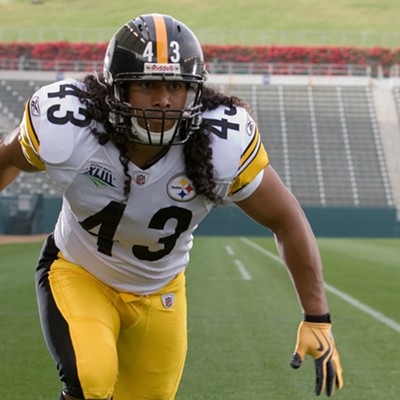Beginning in December 2007, Ronald Petruney lived through 19 encounters with police from the city of Washington, Pa.
Why he died after the 20th encounter, on the afternoon of Nov. 17, 2009 -- the only one in which a Taser was used -- remains something of a mystery ... and a reminder of the questions that surround other Taser deaths.
Police were called to a store parking lot on Jefferson Avenue after Petruney, 49, was seen having a seizure. He had a schizo-affective disorder alongside the seizure disorder, and was known to be combative. After the seizure, Washington Police Sgt. Chuck Mutich tried to keep him from wandering into traffic, but Petruney bit him several times. Mutich and three other officers wrestled Petruney into handcuffs, using their Tasers at least three times on his abdomen and thigh. The electro-shock weapon, which is supposed to immobilize the body's voluntary muscle movements, had no visible effect.
By the time Petruney was subdued, face down on the pavement, though, he had stopped breathing. Though his heart was later restarted, he died Nov. 20 without regaining consciousness.
Dr. Abdulrezak Shakir told a Washington County coroner's inquest on June 17 that his autopsy showed Petruney had 60-percent blockage in one heart artery. During stressful situations, such arteries must dilate to let in more blood and oxygen. And there were many stressors on Petruney during his 25-minute police encounter -- the seizure, the Taser use and being handcuffed after a struggle -- that contributed to his "agitative" state.
"[I]t is the cardiac arrest that caused the death," Shakir said. "But the thing here is, what led to the cardiac arrest?" Shakir noted that while the Taser has been deployed tens of thousands of times, it has been examined or discussed as a possible factor "only in several hundreds" of deaths.
"You do not see inside [my report] any finding that will prove to you [Taser] is the cause or it isn't the cause," he added.
Tasers fire a pair of barb-tipped wires that travel up to 30 feet, attaching to the skin or clothing of the victim and sending 50,000 volts (at low amperage) into the body for a five-second burst every time the trigger is depressed. The Taser can also be pressed directly onto the skin and twisted sideways to maintain contact for a "drive stun."
It is highly popular with police. "It's the best less-lethal [device] I've seen in 25 years," says Monroeville Police Chief Doug Cole. The department has been using Tasers for about four years, less than a dozen times each year. And Cole says the device protects both police and civilians: Prior to its use, he recalls, a lieutenant was seriously injured fighting with a half-naked drug suspect. "We have not had anything since like that," Cole says.
While the National Institute of Justice recently found that "there is no conclusive medical evidence that indicates a high risk of serious injury or death" from Taser-like devices, concerns remain about the device -- especially when used repeatedly on highly agitated subjects.
Locally, Cole says, chiefs began feeling more cautious about the device after the 2008 death of Andre Thomas, a 37-year-old Swissvale man, who died 30 minutes after being subdued with a Taser. His death was later blamed on agitated delirium, a condition often referred to as "excited delirium," and associated with elevated body temperature and internal chemical levels. This was coupled with a small amount of cocaine in Thomas' system and provoked a heart attack, Allegheny County Medical Examiner Dr. Karl Williams ruled.
The Thomas death prompted Allegheny County District Attorney Stephen A. Zappala Jr. to convene a study committee last year. In October, the "Working Group on the Use of Force" issued its Taser recommendations in October. They include avoiding Taser use on passive resistance, drivers of moving vehicles and anyone who could consequently fall from a height. The report also recommends avoiding "any punitive or excessive force," or use on certain high-risk groups, including the very young, pre-teens, the elderly, pregnant women and people in physical or mental distress. (Panel members acknowledged some of these conditions may be hard for police to ascertain.)
The report notes too that multiple or prolonged exposures to Tasers "increase the risk to somebody who is shot" with one.
Did such considerations factor in Petruney's death? It's not clear. Washington police testified they Tased him three times; Shakir said evidence suggested a half-dozen or so uses. But Zappala's report seems to have had little impact on Taser use locally.
Pittsburgh Police, the county's largest Taser user, hasn't modified its Taser policies. Neither have police in communities ranging from Clairton to McKees Rocks, Monroeville and Robinson Township. Brentwood, which adopted Tasers only recently, has followed the DA's guidelines, but other police chiefs say they either had such policies already, or take their cues from Taser International, the firm that makes the device.
"We do follow what the DA says," says Homestead Borough Police Chief Jeffrey DeSimone. "But more important, we follow who supports us in training, and that is Taser International."
"Taser has always had the primary target area as the back, always to avoid the chest area," explains Officer Ron DePellegrin, the borough's defensive-package officer. The company has also told his department to "beware of symptoms of people who could be under the excited delirium," a topic of more frequent Taser recommendations lately, DePellegrin reports.
"We'll see a lot of innovations and improvements in the product," he adds, looking forward to a multi-shot Taser in the future.
Steve Tuttle, Taser spokesperson, says the company does not tell police forces when to deploy the weapon. "We do provide independent resources for best practices," he says.
Taser critics continue to press not for greater regulation but for an outright ban. Debbie Russell, an Austin, Texas, activist, has been teaching workshops at national conferences about what she sees as the dangers of Taser use. She acknowledges that the Zappala panel recommendations are "all considered best practices" by groups as disparate as the Police Executive Research Forum and Amnesty International, a chief Taser foe.
But no one has yet tried to track the Taser's long-term effects on health, if any, Russell says. "We know what happens when you get beat with batons, and people at the hospital know how to treat that," she adds. But such is not the case with Tasers.
As for cases like Petruney and Thomas, she says, explanations such as "excited delirium" are unconvincing. While the condition is being used more often by medical examiners, it is not recognized in the American Medical Association's chief diagnostic manual.
"It's just their way of explaining how they can't explain" what Taser's effect might be, she says.















